Fundamentalist Christians and its Wrong Approach to Spiritual Teachings (17):

Flat Earth; Enclosed Creationism; Conspiracy (Theory), Intuition and Imagination – Part Eleven
.

.
.
The Only Way Out is In [Posted initially on 27th March 2021]: In the last post, we discussed sacred and profane space and touched upon transcending duality and the mysteries of mystic space. This will be a continuation of what we call hyperreal-space [what we come to believe as the container that holds our satellized earth in its place] – compared to what I call space-real [can be seen as spatial concepts that illustration artists are familiar with]. And the transcendence of duality is about recognising that what we call hyperreal space is also what’s inside you.
I mentioned briefly in the last post that a creator’s conformity balances an agenda aspect and their imaginative individual commitment. Expounded in the film Mulholland Drive depicts Hollywood Types with money to make the film; they are particular, weird and hard to please. These types are known as ‘studio mafia,’ However, even those types [producers] work for somebody else […], which can be known as a sort of Hollywood conspiracy. And this is a bigger idea than a producer’s preferences. The balance between an agenda and an imaginative commitment is examined, notably in a scene – where Adam Kesher, the director of The Hollywood Dream, protests that the film is his. However, the studio mafia responds, saying it’s no longer his film. This shows that Adam has no final Cut, nor does he have the option to begin with.
Diane befriends Camilla, an amnesiac woman; they both get driven up to Mulholland Drive on separate occasions, and the driver stops on both occasions. Two different depictions of the same event suggest Diane and Camilla are the same people with split personalities. Illustrated when Camilla changes her hair to resemble Betty’s, they go to Club Silencio, where Betty receives some revelation that makes her shake in her seat. And when they arrive home, Betty disappears, leaving Camilla to take the lead role in the dream with her Betty-style haircut. Diane ceases to be Betty and becomes Camilla.

The terminology ‘casting-couch’ is a term that’s known in the industry to mean another thing, notably sexual favours. Camilla also represents the casting couch as a human form abstraction. In Diane’s Hollywood dream, Camilla Rhodes is the blond girl with the pearls because she is a casting couch actress. This outlines that the brunette woman Camilla Rhodes is not a real person. Between the two main points of the film – when Diane enters the Hollywood studio set and when she opens the blue box- is a transition showcasing Diane falling in love with the casting-couch idea. This is a setup as a transition scene. First, there is a death scene in an apartment where both witness a dead body [the dead body is Diane/Betty]. This is to showcase Diane’s symbolic death of her naive dream and a wake-up call to reality. Camilla reacts strongly, but Diana does not because both Diane and Betty are too naïve, but the part that is Diane that is Camilla is not. The other is when Diane ritualises her idea of falling in love with the casting-couch idea [or being a movie star], which is depicted in a sex scene with Camilla [with herself essentially].

The Blue Box represents silence, the actual conspiracy when Diane shakes and kills off her naivety to be part of that Club, a club of silence [Silencio]. This is depicted in a scene when Diane and Camilla return from the Club. Diana holds a blue box with a blue key to unlock; she puts it on the bed. Then, Diana disappears. She disappears because she becomes the new Camilla Rhodes. The film conveys this when Camilla opens the box, and the camera zooms into the box, signifying Diana’s entrance or entrapment into the Club of Silence [blue box]. Diane had the blue Key beforehand, shown towards the film’s end. Diane has decided to prostitute herself for that dream; she gives her inheritance to a bloke named Joe. Joe is the sleazy equivalent of the real Hollywood as opposed to the dream; he is also a sort of Hitman. Joe holds the Key to that dream, which Diane now has.
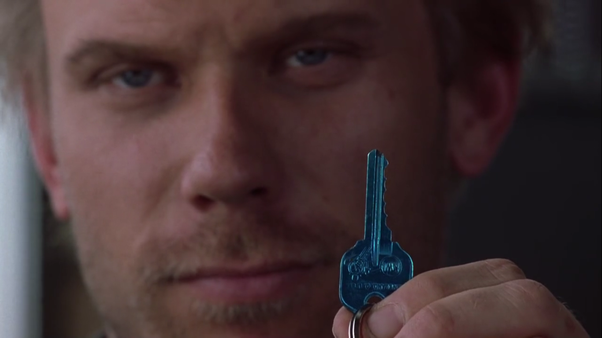
| Pearl = innocence | ||
| Blue Box = Silence | ||
| Music = Movie magic |
.
David Lynch has always used music to set a tone, and his 2002 movie had subliminal layers with situations regarding the many implications of behind-the-scenes movie productions. With the fall of Weinstein after which made public, Lynch hinted at this kind of perversity in this flick [The Other Side of the Hollywood Dream]. Rose McGowan is one of those at the forefront of that takedown. She recently started her support to the victims of abuse by Marilyn Manson. She mentions Hollywood is a cult but emphasises that the entertainment industry is also a cult, including the music industry. McGowan herself was engaged to Manson at one stage.
I remember Manson once hosted an Australian show, Rage, as a guest. The guest chooses his favourite music videos for the public. One of his choices was Celebrity Skin from Courtney Love. He gave a short remark about the old Courtney from the band Hole in Contrast to the new Courtney on Hole’s most successful album. At the time, I never understood why he gave a contrasting comparison to such a typical process for success. Until it dawned on me [my subconscious always connecting dots] about Mulholland Drive’s implications regarding falling in love with the idea of casting a couch and being initiated in a box of silence. For Courtney, it was about falling in love with the idea of (the occult of) Fame. The documentary film Kurt and Courtney outlines details concerning the accusation that Cobain was murdered as opposed to suicide. The film suggested that the primary motive for the crime was due to the inheritance of Kurt’s assets and wealth, but I feel it’s more than that.

Courtney’s first album didn’t take off, but the album Live Through started to get recognised due to Kurt’s help as a ghostwriter; many others claimed this as well. Four years after Kurt’s death, they released Celebrity Skin, seemingly a success; more success would ensue, leading her to the quintessential Hollywood dream.
In the last post, we discussed the synchronicity around the X symbol. Kurt’s influence on music is so visionary that no other influence has ever had a more significant impact afterwards. In the Greek canon, the symbol Chi Rho [also known as Jesus], which is the letter X and P placed together to form a six-pointed cross, which is also the Cube, X and P in gematria is 3 and 3, which equals Six. 3 and 3 are also 33, which is the length Jesus lived. In gematria, the names Jesus, Nazareth, Light, Lamb of God, and Chi Rho are all equal to 27, and 27 is also the Trinity Cube via 3x3x3=27. Kurt is part of the club of famous people who died at 27. Kurt is a proxy sacrifice of light from a Siren [… guess who …] woman for whom the watchers fell. In the First Book of Enoch: Chapter XIX. 1. “And the women also of the angels who went astray shall become sirens.”

There is also the rune X, which means Gebo: “gay-boo”– literally: “gift” – esoteric: fair exchange, sacrifice, sacred marriage – “for every gift a curse.” The Kurt and Courtney documentary depicted a home video of them between momentary lucid and high bathing their child, and at the time, both proclaimed a moment of happiness. Trying to make sense of a relationship between a Narcissist [malignant or vulnerable] and an unhealthy codependent empath will only leave you confused. Did they genuinely love each other? Whatever the case, there is always something larger at play.
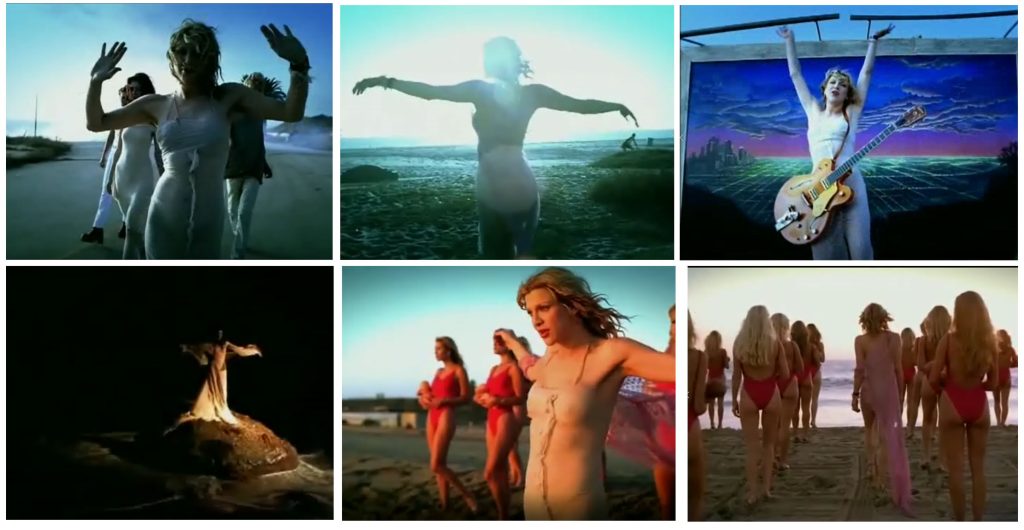
In her music video clip “Malibu”, she thanks the Goddess of the Sea with the Gebo pose. An X marks the spot for the Pearly Dew Drop – pearly dew-drop is the fall of angels; X is where they fall, also called the sacred centre. The sacred centre is an Eliade-like concept regarding Odysseus. He had to pass through the island of the Sirens before reaching the centre, a.k.a. sacred centre. Courtney’s band name is ‘Hole,’ a hole by any other name, such as a Navel, the World Tree, or sacred centre.

The Journey to the Sacred Centre: The Iron Age poets’ understanding of the world axis provided a pivotal mythological concept that is timeless. In contrast, sceptic science introduced the same concept [however, infinitely outside oneself] of the world axis as the earth’s axis on a spherical orbit. This axis is an imaginary pole that tilts at 23 degrees; this imaginary pole is a secular debasement of the sacred Pillar. Hyperreal space stems from Mircea Eliade’s notion of sacred space and boundaries. This comes from his analysis of the ‘Odyssey’ in which he derived these notions of sacred space and boundaries; this sacred–space is the space around the centre, the centre being the world axis, also known as the world tree, the Pillar, and the mountain. And unlike the earth’s axis, it doesn’t adopt made-up modern cosmological notions.
The juxtaposition of differences in the contours of worlds and their axes finds its commonality in the centre, the New Age’s notion of inner worlds, flat Earth’s notion of Mount Meru and Atlantis, and even the hyperreal notion of galactic centres. Timeless archetypes and myths concerning the human condition evolve around their own central pillar. The Odyssey is about Phaeacian Island Scheria [also known as Plato’s Atlantis] in contrast to Ithaca, Odysseus’ home world.
One of the many interests Romanian historian Mircea Eliade was contented with was the symbolism of space and spatial orientation, made more apparent in the singular understanding of the Centre [Center], also known as the Axis Mundi. This motif of the world, the Navel, the mainstay of heaven, also known as Axis Mundi, is a term he coined, but the concept was not his. In a way, Eliade inspired hyperreal-space and spatial concepts in Homer’s Odyssey’s grand story so it can fit nicely into a sterilization concept. In a post-Flat-Earth-hype, it just made it more confusing. Or it’s just about identifying two separate concepts but ultimately coming from the same idea.
Eliade describes spatial concepts as boundary situations where characters or individuals come to recognise their place in the universe by becoming conscious. Such self-revelation fosters an awareness of the dichotomy between one’s sacred space and the profane space of the other. Sacred space is a microcosm of the external world; it’s consciously delineated, set apart, and ordered, but outside the sacred space, a contrary world exists, characterised by formlessness, chaos, and danger. In this cosmological framework, the world comprises many concentric circles, with the centre representing a sacred space surrounded by a profane circle. Eliade posits that the heart of sacred space is the most sacred, as it embodies sacredness through revelation, epiphany, or hierophany. This concept is inherent to humanity and is fundamentally necessary for human society. Every society inevitably exhibits this understanding of a ritually delineated centre for the encounter with the sacred, consciously or unconsciously.
The simple consequence of living in three-dimensional space while keeping within them the notions that some people, places, and things are sacred while others are not. These centres are expressed in several forms, primarily manifesting in cultic objects or abstract symbols – such as the world tree or pillar holding up the heavens, both appearing as symbols in the Odyssey. Eliade conceived that the powers of these centres are derived from the point of intersection between the celestial world (Mount Olympus) and Hyades and the world of Men (material world). In these centres, plane ruptures occur (this is where communication is said to pass between these separate planes). The conduit for these communications, according to Eliade, occurs through the motif of the axis Mundi (world axis), which at once connects and supports heaven and earth and its base is fixed in a world below.
It’s from this universal pillar at the centre of the world from which the entire world extends. If we think of it this way, all other centres are merely imitations eternally repeating the same archaic image: the cosmic mountain, the world tree, the central pillar, etc. In light of this, Eliade proposed a multiplicity of centres with a transferable nature. During the flat-earth hype, they mention other lands beyond the ice wall. The ice wall being Antarctica, and beyond Antarctica are possible outskirts of other centres from which a dome acts as a separation barrier. However, I believe the notion of a dome begins and ends in the firmament. In light of sacred space, you can assume the hyperreal-space cosmos’s whole motive was to separate you from the sacred. The multiplicities of centres are now solar systems among an infinite number of other solar systems in tangent orbit around a galactic centre.
One of the many premises in Homer’s Odyessy (and Return to Ithaca) was about Odysseus losing himself in a land of mystery, magic, and gods. Odysseus’ journey from one sacred space to another is a quest to find his sacred space and return to Ithaca. Modern-day retellings come in the form of sci-fi shows like Battlestar Galactica Lost and aspects of Deep-Space-Nine, such as Captain Sisko embodying aspects of Odysseus himself. In Battlestar Galactica, Kara Thrace embodies a particular archetype, a prophet whose destiny is pre-destined. In the episode ‘Maelstrom’, she enters a symbolic centre with her spaceship and dies … well, everyone assumed she had. Symbolic Centre works in tangent with the Eye of Jupiter symbol she envisioned before it was known to others. The symbol was embedded in a temple, a road sign to Earth. Earth is Ithaca in this instance. Kara returns to life in a messiah-like fashion in the crossroads-part 2 episode. She tells Apollo, “I’ve been to Earth; I know where it is, and I’m going to take us there.” Kara Thrace to the Cylons is described as an “Angel blazing in the light God, an Angel who will lead her people home.”
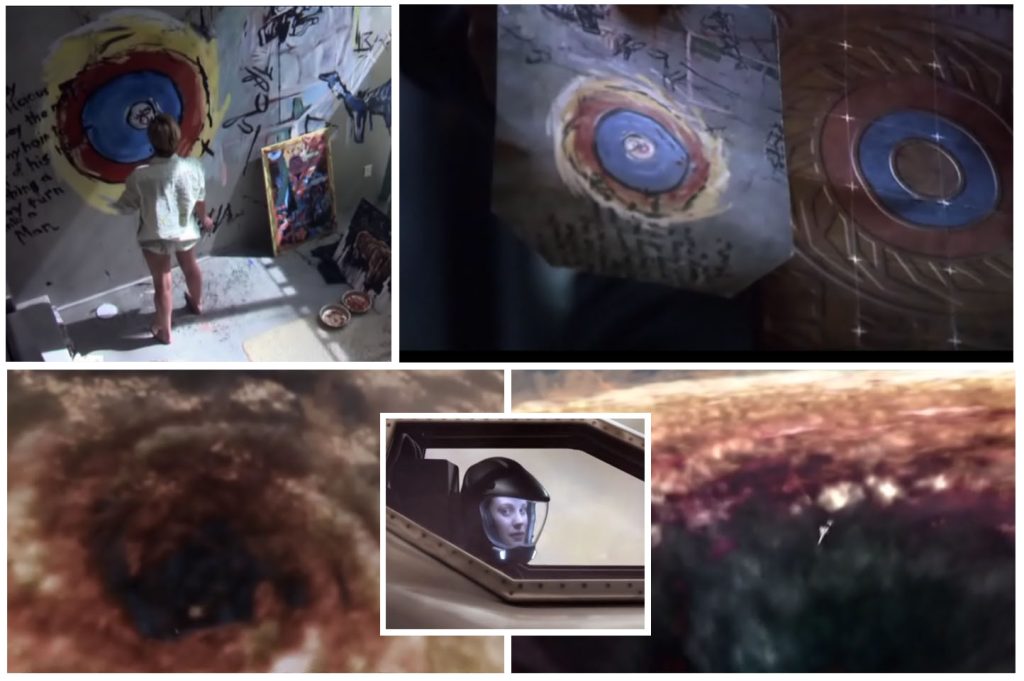
There are references to maritime centres being focal points for sacred spaces, serving as intersections between heaven and earth. The pillar often symbolises this connection, mythologised through the Greek god Atlas. The idea of a world centre is transferrable, suggesting that multiple centres can emerge from a single narrative. Notably, the “Center of the World” concept is not a fixed location; it is subjective and can shift depending on the narrative’s focal point. This notion can be interpreted in various ways, though it is primarily understood through metaphors. One prominent narrative or paradigm presents the sacred space or centre as a galactic entity in this context. According to Astro-Gnostics, the Pleroma exists in this realm as well. Additionally, there is the possibility of a literal interpretation of the centre itself, separate from the symbolic metaphors of narrative points. Flat-earthers hold this viewpoint, believing the centre is located at the North Pole.
In the TV show Lost, which is about groups of people who crash-land their plane on an island, the group finds the island filled with mystery and magic. In some ways, the island embodies the world-center motif. The island has a centre in which a mysterious light exists that the island’s caretakers have covered – to keep evil entities from entering the island. This is a nod to the ruptures of planes that Eliade alluded to, how ruptures allow communication between planes. The island acts as a location and an entity with no fixed locations. It continually moves. Then, the island reveals that electromagnetic pockets exist and a hidden ancient wheel exists underneath a specific research station. By turning the wheel, the island moves. The wheel becomes dislodged, making the island move through time. This seems to exemplify the world centre of the lost island, which has no fixed location but moves depending on the narrative’s focal point. Or the focal point of the co-creator as they tell their story [narrative].

The concept of the world’s centre—represented by symbols like the Tree, Mountain, and Pillars—serves as a reference point in space where past experiences and revelations can be anchored. In the ancient Mediterranean, the idea of a sacred space was dominated by a central point, where one centre’s experience was interconnected with every other. Each centre represents a boundary situation akin to what Eliade described, involving moments of personal reflection and subsequent revelations. The show Lost illustrates this interconnectedness through flashbacks of key characters, highlighting that their experiences are linked and exhibit a sense of synchronistic causality. As they reflect on their journeys, their insights have meaningful synchronicities. The characters find themselves on a magical island, representing this sacred centre—a literal sacred space—juxtaposed against their ordinary lives or profane centres. This sacred centre is so profound that it defies rational explanation; it has a familiarity that can parallel meaningful dreams and such analysis of the mystical realm of memory, influenced by imagination and dreams. Describing these deeply symbolic and surreal experiences is akin to explaining prophetic dreams, where the essence often gets lost in translation. This familiar centre, as tangible as the profane one, is understood through revelations that resonate with the island’s central light source.
Battlestar Galactica is set against the backdrop of hyperreal space. The show mashes myth and secular notions. For example, conveying that our long-lost brethren are ancient aliens that travelled among the stars to reach Earth. Once they arrive, they co-mingle with Earth’s natives, and the natives, in reverence to them, will become known as cargo cults. In this regard, space is an extension of the Pleromic Galactic centre, signifying a sort of infinite sacredness, but at times, it is limited to made-up astronomical rules. Each planet they visit is a journey from one profane space to another. Even when they thought they’d reached Earth, they discovered it was desolated as their collapsed empire planet Caprica. When they reach their new Earth, their Ithaca, it’s a relatively new planet. This is as close to Eden as they possibly fit in their worldview.
Back to Ithaca: In the Odyssey, the boundary situation is revealed through Odysseus’ moments of reflection and revelations. Upon being washed ashore in Scheria, Nausicaa, daughter of the Phaeacian king Alcinous, sees him. He pondered whether he had encountered a goddess or a girl with significant beauty; he asked, ‘Are you, god or mortal?’ If you are a god who holds light heaven, I think you are nearest Artemis, great Zeus’s daughter in figure or stature. However, this moment of doubt his mind offsets when Nausicaa’s appearance elicits a vivid memory in Odysseus’ mind while he stands locked in amazement. This amazement and beauty remind Odysseus of a palm tree that grew next to the altar of Apollo in Delos. For centuries, the ancients described Delos as a mythical centre of the Greek world as it was presumed to be an island that held the World Navel [or Olympus]. Therefore, the tree next to the altar at Delos would be an explicit centre of that world tree, which Odysseus recalls as the godlike Nausicaa. The immediate space around Nausicaa (because she is a goddess) becomes sacred at that moment. This event would set the tone for the remainder of that particular episode among the utopian Phaeacians. It’s as if hierophany [manifestation of the sacred in whatever object (symbols)] of the divine participates in one archetypal experience outside of time and space – which is so strange to its recipient that it can only be conveyed by metaphor, by recalling other examples of that experience.
Not long after this scene on the beach, Nausicaa plans for Odysseus to enter the Phaeacian town and be drawn into a new orbit Centre. These would be the pillars of Achanious’s palaces. From this point onward, the new Centre will become one of two dominant centres of the narrative – the central pillars [palace] of Alchanious become sacred space counterpoint to space around the pillars of Odysseus’ own Ithaca. Odysseus convinces Nausicaa to take him to her father’s palace. She gives him directions and instructions to find her parents’ palace and who might be able to secure safe passage home. She gives the Phaeacian city’s beautiful flowing geographical orientation with its walls, towers, shipyards, temples, and sacred groves. Odysseus is to travel through these landmarks; after that, he will reach the palace of Alcinous. He would enter a courtyard where he would find Nausicaa’s mother leaning against a pillar with her handmaidens. A sight to behold, and next to the pillar is King Alcinous. A pillar is an object with symbolic significance. It stands between the Phaecian King and Queen. It becomes a focal point, a symbol of the royal family’s godlike nature and of Odysseus’ longing to return to his world and the pillars of his halls. Once Alcinous and Odysseus meet, the king promises he will guarantee Odysseus’s return.
Phaeacia is a sacred space in a purely Eliade-like sense. It’s ordered and set apart; it’s safe and free from the chaos and unpredictability of the sea. It’s a land where gods are known to come down from the skies and feast with men. So, it would come to light that Odysseus would be part of this feast ritual, and a song is played during the feast. There are two Eliade-like boundary situations. One concerning a quarrel between Odysseus and Achilles at Troy, this moment is a self-revelation and an expression of power, characteristic of sacred space. The second is an affirmation scene in Ithaca from Odysseus’s Wife’s point of view. His wife Penelope stood beneath a pillar during a feast. She is moved to tears by the barred Athenian song, which floods her with thoughts of her husband’s absence and a realization that her own sacred space was incomplete and violated. Ultimately, the pillar barred and the realization of separation links these scenes together. Having spent time in the city filled with gods and magic, Odysseus still realizes that this sacred space is not his own. This is affirmed through these boundary-like situations.
The Phaeacians are prepared to send Odysseus home. We have a farewell scene between Odysseus and Nausicaa, which takes place beneath a pillar. Afterwards, with her god-like beauty, Nausicaa stands beside a column of a densely made roof, which reminds Odysseus of his life in Ithaca. He replied, “Nausicaa, would their heiress, loud, thundering husband Zeus, make it so that I may go home to see my homecoming day? I pray to you then, even there as a goddess. Every day, for you, my girl has saved me.” The ambiguity of the first scene regarding whether or not Nausicaa is a goddess, with its digression to a palm tree at Delos, is retained in this farewell speech. Odysseus makes a vow to the gods [religious act], promising that upon his safe return home [arrival to his own sacred space], he will remember and pray to the girl as if she were a goddess. Nausicaa symbolises his safety and reintegration into his sacred space after being lost amidst the sacred world.
As Odysseus bids goodbye to the girl next to the pillar, he bids goodbye to the Phaeacian palace and, by extension, to all the lands it governs. The departure of Odysseus marks the end of the Phaeacian utopia. This episode attests to the highly personalized and subjective nature of sacred space and its proneness to the ravages of the profane world. Once its boundaries are not well-maintained, the gods grow angry when the sacred qualities of the Phaeacian utopia are spilled out into the profane world in the form of escorts on magical ships from strangers lost at sea. The poorest boundaries of sacred space reveal the tenuous nature that the Phaeacians send away from their island. That is when they send pieces of sacred space outside their divinely sanctioned boundary. Both Odysseus carried the chaos of the profane world to Alcinous’s hall in the form of Poseidon’s wrath, and Alcinous granted safe passage to all exporting sacredness.
We see that it’s ultimately poor management of boundaries in the eyes of the gods, which is responsible for the mountain eventually being brought down upon Scheria. This is the disaster that snuffed out all the Phaeacian sacred space. By its very nature, sacred space can only retain its sacred character insofar as it’s set apart from the wider world. When it’s open and available to everyone, it loses its sacredness and set-apartness, diluted and swallowed up by a more prevalent profane world. Upon reaching Ithaca, Odysseus’ struggle will be re-establishing boundaries and expelling his sacred space from the profane world that has spilled in from his 20 years of involuntary absence and powerlessness to maintain his boundaries.
We see the Eliade-type model of sacred space with its centre based on the presence of an archetypal model axis Mundi – a vertically aligned tree or pillar that works happily within the Odyssey. It acts as an archetypal model now, although it may have been real throughout the early gestation of Man and civilization. We’ve seen how the symbolic objects set the scene for boundary situations when characters become acutely aware of their place vis-a-vis sacred and profane space and subsequently have an epiphany or revelation.
And let’s remember enlightenment, which can be defined through mystic space and a gateway or a peek towards sacred space. Why do many of Alex Grey’s prominent paintings signify faces morphed into psychedelic symbolic pillars more than coincidence? [He (Odysseus) would enter a courtyard where he will find Nausicaa’s mother with her handmaidens leaning against a pillar … a sight to behold.] Odysseus longs to be in a profane space when he has lived amongst gods and the sacred; Odysseus still wants his own sacred space, which is defined by his wife, Penelope. In a way, Penelope and the halls of his pillars are sacred spaces of his liking, an axis of his world. In doing so, it contrasts these centres – from the bittersweet utopian land of the Phaeacians and the much sought-after ruins of Ithaca.
New-Age and Hyperreal-Space Eschatology: However, it is about an inherent longing to seek out that sacred space for the rest of the people within the profane space. A staple quality of (Astro) is Gnostics, who feel intuitively in some way that this world is not their actual world. Also, this intuitive longing is purposely being hidden from the people. There is a plot, perhaps a possible conspiracy – or various forms of resistance that are agenda-driven – to make such notions of sacred/mystical centres a nonsensical one.
Flat-Earth-New-Agers draws upon these old myths of profane and sacred centres while adding their truths to them. For it to have some credibility – they back their claims through multiple spokespersons that have been part of mind control programs and underground cloning facilities. What does Flat-Earth have to do with Mk-Ultra and underground cloning facilities? Its relationships rely on the claim that these subjects, now disclosure agents, were part of secret space programs now called breakaway civilisations, given space as we commonly know it is a misnomer.
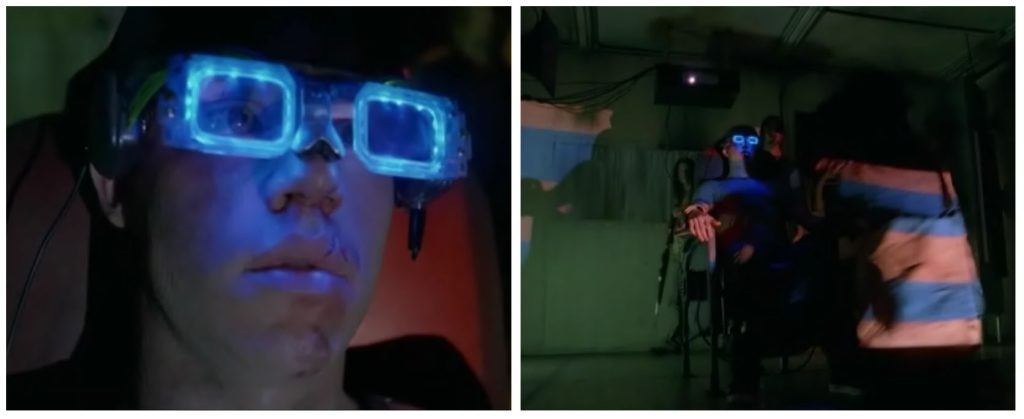
They view these multiple differences in reality as dependent on how one can extract meaning from them. The dome version could have been disinformation. At the same time, it can have merit where the dome is simply the depth of space and void, where the electric-magnetic field of the earth is a field that no human can enter. The electric-magnetic field works symbiotically to keep life going. It’s like the field works as a soul for the earth; as humans, our energy and consciousness are tied into this field. If it were to leave, the body would shut off – the soul would return to the ether. And the body would just be there, floating in space. The dome signifies reality for the soul. However, it doesn’t mean humans can’t go out there. A substance commonly known as ‘black goo’ bombarded the planet. This foreign consciousness imbued itself to our planet, resulting in a mineral with a unique crystalline structure. Suppose one separates that or takes a piece to create a shield around a craft. They can leave the earth’s dome or electric magnetic shield to travel at that point.
Hyperreal-space notions and common scientific reasoning are described differently through the subject of MK-ultra to give it more credibility. Mind-control [Mk-Ultra], a subject about altar egos, soul transference, handlers, clones, celebrities, trauma, and teleportation, is always a mixed bag of possible truths with science-fiction added to it. At least science fiction gives us entertainment value when it’s in its proper lane. Testimonials from Mk-Ultra subjects now paid public-relations actors with close ties to hoax actors lose credibility in an instance as soon as they mention notions of teleportation. Being able to teleport from one facility to another espouses science fiction or something that comes out of ufology. Their heads often jumbled so much – which they started to believe their fantasies. Where once alien abductees were the norm, these guys are the new norm but leave the ‘science-fiction to the writers. Teleportation – Star-Trek and Fringe: Black Goo – X-files and Prometheus. The Black Goo, commonly known as Black Oil, was about psychotropic drugs used for mind-control programs.
The New Age and traditional Christian worldviews are dependent on the hyperreal-space worldview, and their flat-earth tangents merely work as damage control for them. They adopt various composites of narrative to their agenda, for instance, regarding my last post about memory and reason. We discussed memory seen through an unfathomable form of romanticism, which is geared towards shaping the unfathomable with experience to a romantic vision that often morphs into (cult) groups. That imbues perfect love, race, and nation, ultimately a deformed version of memory. New-Age-Flat-Earth and Christian-Enclosed-Creationist groups embody these characteristics of the romantic vision in their way. New-Age-Flat-Earth groups rally behind their Mk-Ultra disclosure/spokesperson agents because they believe them wholeheartedly when they say they’ve been to the centre. [I’ve been to earth; I can take you there, a notion of Starbuck]. There is a messiah/prophet complex to these testimonial agents. They say the only way to enter this sacred space, this centre, is to transcend their duality fully. I believe that they were mind-controlled, but anything beyond that is a deformed version of memory. They’re just mixing unfathomable forms of romanticism with new-age notions.
The notion of transcending duality as a critical component to entering the sacred centre/vortex is an Eliade-like idea concerning liberation. He calls it the ‘refusal of history’ or the ‘myth of the eternal return,’ which was about cycles of time or a cosmic reincarnation of the world. The transcendence of duality [or liberation] is merely about understanding existential evils and suffering and having a means of minimizing it during the reincarnation process. He suggested a concept of accepting liberation, so when juxtaposed against the vast cycles, it changes people’s worldview—not curing suffering but rising above it and out of it. I doubt it’s about an exclusive practice of oneness. People enter this sacred centre every night. Terence Mckenna once suggested that when we dream [mystical-space], we go into another layer, a deep absolute [supreme-being] dreams we have no memory of.
Their bold claim is to suggest that memories are not stored in the brain but stored somewhere else and that within each clone, they can re-trigger or download those memories onto them. They can also re-trigger those memories to their original bodies if they wish. The memory aspect is taken from Sheldrake’s theoretical assumption that memory may be stored elsewhere. New-Age-Flat-Earthers, however, conflates his meaning. They miss his notion about telepathy-type interconnections between organisms and collective memories within species. There have also been discoveries about genetic memory encoded in DNA, which raises many questions about tribal groups that link back to the earliest family tree and the first Adam. You can evaluate that Sheldrake is a Jungian, equating his theories from the collective unconscious to collective memories. The ability to lock and unlock memories through Mk-Ultra trauma-based programs is another mixed bag. The ability to create soulless beings to do their bidding by activating personality types and false memories through symbols and triggers is probable. However, to claim the ability to capture consciousness or compartmentalize it regulates the soul to an etheric substance that can be controlled and redistributed between bodies – seems purely science fiction.
Where have I seen (heard) this before? Battlestar Galactica. The Cylons or Cy-clones have a ship called Resurrection to re-integrate the Cylon’s memories into a new body if they should die. To assume that it’s real would be a degradation of the individual and the spirit. And this has been a long story-telling fictional trope. This is the golem or Frankenstein character; these characters come back to life but are not quite the real person that came back, but a shadow of their former self. So, when they say subjects [seen in pop star icons] that spaz out or break down are due to consciousness snapping back into the body. Such a case may suppress memory or suppression of the true self coming back to the surface, but because of the degradation of the body and mind, it’s out of synch, so the body and mind break down. This is an extension of Einstein’s notion that time travel cannot exist, but perhaps consciousness travelling through time can—a trope adopted as an effect for story-telling, notably the science-fiction idea of time displacement.
The show Lost shows this example, where Desmond and the other by Charlotte. Desmond’s consciousness travels back into his younger self’s body, while his younger self’s consciousness travels to his present self’s body. A swapping of consciousness from present sacred space to past profane space and vice versa, but with each travel, the body is degraded. At the same time, Charlotte finds herself on an island (sacred space) moving in time, the displacing issue made apparent because the island’s wheel rim had been dislodged. During these time flashes, Charlotte’s body and mind start to deteriorate faster than the rest due to having lived on the island as a child.
They believed in their conjured hyperreal-space simulation so much that they’d forgotten it wasn’t real. The same can be said about these hyperreal-genetic-determinists equating the body and soul to a machine, but the aspect of soul and consciousness always thwarts them. The error comes in determining memory acts as the soul. Transhumanists have been trying to solve this roadblock for decades and have consistently failed. If true, it would be less about common P.R.’s promotion of longevity and immortality. Instead, it would be about the imprisonment of consciousness behind the curtain. Somewhat playing on the half-maker’s descent out of the Pleroma and his jealousy of the human spirit and the spirit’s journey to heaven.
The breakaway civilizations are a grandiose rebuilding of Phaeacia (Atlantis) – but this attempt will always be a poor copy of the original. It may establish a similar trait insofar as it’s set apart beyond the fact that it’s missing a few criteria. The sacredness quality, gods, and the location being established beyond the ice wall are even farther than the profane; there are no literal pillars. Aside from these missing components, they’re also overly concerned with death, judgment, and the soul’s final destiny. They think they can bypass these concerns through their ace in the hole, betting it all on their technology derived from Nikola Tesla and crashed Archons (UFO) crash sites. Breakaway societies throughout history have always been in the form of secret societies. However, the manifestation to make it literal and exclusive came about through technologies that inspired them and other nefarious reasons.
Flat-Earth-Christian-Fundamentalists and the Hyperreal-Space Eschatology: For flat-earth fundamentalist Christians, the understanding of sacred space/centre is similar to that of New Age Flat Earthers, both adopting esoteric thought like the Fibonacci sequence and Phi ratio. Enclosed Creationist Flat Earthers claim that the (inverted) vortex [centre] pushes down on the centre, creating ocean and wind currents and gravity.
However, what sets them apart is predictable at this point. Notions of transcending duality are out of the question; they see this as a deception. To them, it has to be one or the other; you’re either for Christ or against him. You cannot be for Christ and against Satan; there are no grey areas, and God does not have grey areas. We’ve long discussed the (non)-existence of historical Jesus to that of the Jesus [Logos], an archetypal staple in the spiritual drama, and that there is a clear distinction. This aspect of history in and of itself is a grey area, which makes the memory of it unstructured. So, this claim, ‘you cannot be for Christ and against Satan,’ is a conflation opinion passed on as truth to God. It’s as if they have this psychotic reaction to not admit certain historical myths valuable in understanding the whole story. They do this by mentioning Satan the Big Bad as often as possible, as well as the Triple 6, without giving it context. [This is where they conflate their interpretation of God].
Fundamentalists are not all the same, and those who lean towards a belief in a flat earth are open to New-Age notions only to a point that can match biblical revelations. So it’s a clear ‘no’ to ‘transcending duality’ and ‘no’ to the hermetic reference of ‘as above, so below’ but yes to sacred geometry and the Fibonacci and Phi sequence. I don’t know if it’s hypocrisy, contradictive or selective acceptance, though you will soon see it’s all above.
Flat-earth-fundamentalist Christians believe in a new Jerusalem and that this new Jerusalem will be encapsulated inside a Cube. This new Jerusalem will come from heaven within a vortex and land in the sacred centre. They see this as a marriage of Christ’s returns, but it’s a flat-earth update concerning the sacred centre with the second coming. Revelation 21:22-27 describes the nations walking by the light of the New Jerusalem. After the second coming, the New Jerusalem will replace the Sun as Earth’s light source. Also, Revelation 21:22-27 describes the Kings of Earth bringing their splendour to the New Jerusalem but says nothing impure can ever enter it, only those whose names are written in the Lamb’s Book of Life, which describes the believers and followers of Christ. This Cube is made of gold – because it is referenced in Revelation 21:15-18: … 17 – And he measured the wall thereof, and HUNDRED AND FORTY AND FOUR CUBITS, according to the measure of a man that is, of the angel. 18 – And the building of the wall of it was jasper: and the city was pure gold, like unto clear glass.
Once this new Jerusalem comes down, ‘heaven and earth are made new,’ God will recreate everything perfectly without flaw. They believe 144 Cubits is also a reference to the pattern of the Cube found in the Fibonacci sequence, where you will find the infinite golden mean. The Cube is also 42. They believe we are in Satan’s upside-down world, a false cube. And the real Cube is the Tesseract. The Tesseract is also called an 8-cell or regular Octachoron or Cubic Prism in advanced geometry. It’s a virtual hypercube that can project a mirror image of one dimension onto another from the inside out before flipping one perspective into the other. It appears to have passed from 3d to 4d during a simulated hyper-dimension event.
In 21:16, the angel measures the city with a golden rod or reed and records it as 12,000. In ancient Greece, the measurement of 12,000 Stadia was 4.9 million square kilometres, about three-quarters of Australia’s size. For comparison, we can only reach up to 120,000 feet high or 22 miles. For a secular heliocentric view, the Cube would pass the moon by 384 km and encompass a whole country and more when it lands. For Flat Earthers, this would pass the celestial planes, what we call planets and reach the sky. In other measurements, 12,000 stadia is 2220 km [1380 miles].
| Secular Moon | 384,400 km | 238,855 miles | 1,261,154 400 feet |
| Mythical Cube | 2220.000 km | 1380.000 miles | 7,286,400 000 feet |
| Int. Space station | 386.00 km | 240.0 miles | 1267 200 feet |
| Max. Reach | 36.53 km | 22.7 miles | 120 000 feet |
.
There is also the astro-theological connection to 144 cubits. The square root of 144 cubits is 12, and there are 12 tribes of Israel, 12 apostles, and 12 hours a day. One hundred forty-four cubits are usually measured or equal to 65 meters or 72 yards, which is assumed to be the thickness of the hyperreal Cube wall. However, let’s get – [sing it] … ‘back to life … back to reality,’ New Jerusalem has always been about the building of the Third Temple, which is said to be built in the City of David or Zion. Even Swedenborgians describe New Jerusalem in the Bible as a prophetic description of the New Church.
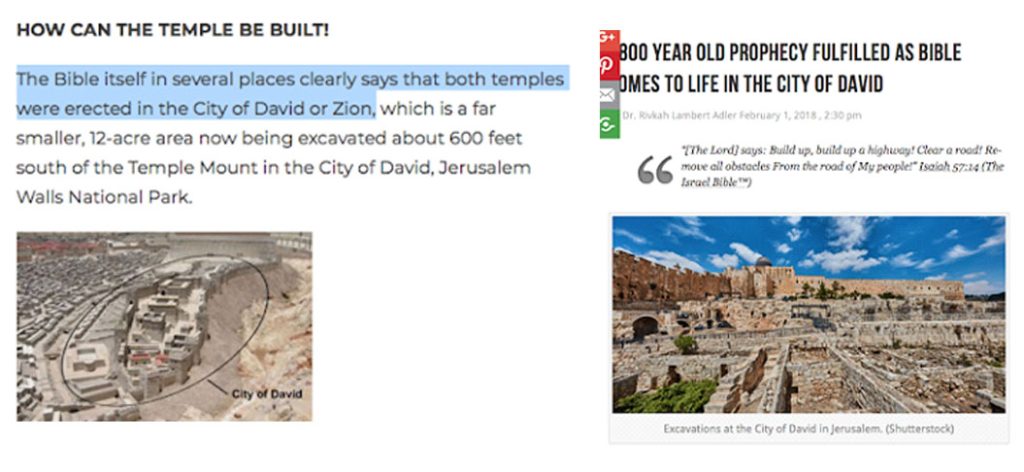
When you look at a Cube, you’re also looking at sacred Geometry, and the Cube also means Kaaba or Kaballah. There are six sides in a Cube. The Cube is a geometrical representation of the human body. The Cube encapsulates the divine principles of creation. The number 6 in occult meaning means Christ or Anti-Christ, and anti-Christ means who would follow after Jesus, and it’s not opposition, but a replacement. Anti-Christ means replacement after Christ, whose number is 666. This is called apostolic succession. Every Pope is known as an anti-Christ god-proxy. Further, into occult meaning, it’s the crystal light divider and sex origin. Breaking down the triple 6 in its letters or gematria equals 653, 6+5+3 = 14, and 14+14+14 = 42 – So, you can’t accept and deny another aspect of the same thing. In Revelation 13:18, 666 is not Satanic but is described as wisdom, and the number of men in the Slavic division of Jesus is JE=45 SUS=666. Logos is the original Greek word for ‘word.’ We associate logos as a symbol made from geometry, which interconnects with numbers. And the word God is Pi. Forty-two means… the oneness, the word of God, and the 42 generations of Christ.
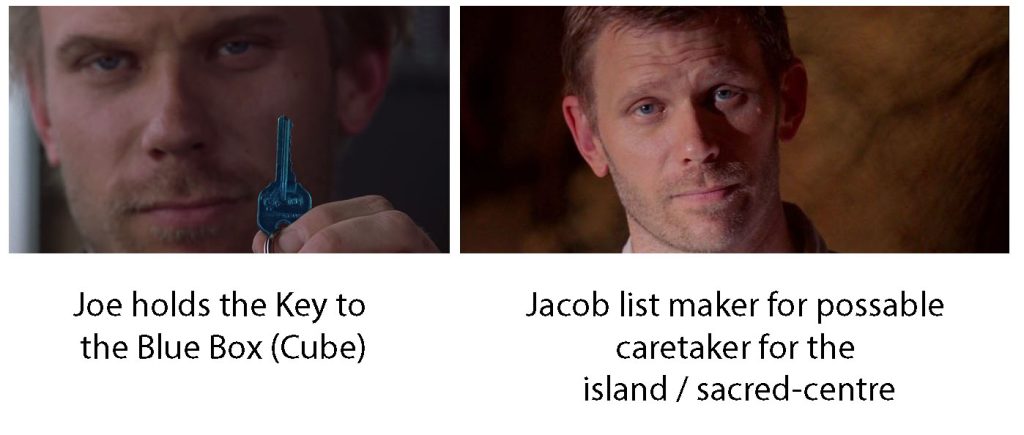
One of the names in the 42 generations of Christ is Jacob. In Lost and Mulholland Drive, the same actor plays the symbolic reference. Jacob’s list of contenders plays on Moses’ roll call of redemption linked with atonement (reconciliation with God). The Book of Life held much meaning for other world religions as well.
Though transcending duality may be a watered-down claim to that of greater meaning, it plays on the notion of oneness in some ways. The Tesseract is simply a three-dimensional representation of principle in the sequence of the Fibonacci. When you follow the spiral to oneness [or the centre], it reaches a point where it restarts again, forever repeating its cycles. Does it mean you moved the dimensions? The movement of dimensions, in this case, means the New Earth. Not necessarily; it could mean the end of time or the end of an age. The Cube-Tesseract implies a dimensional change without actually moving dimensions because the Cube-Tesseract is the catalyst that would change the world on an atomic level.

However, the Tesseract is a conflation of the mythical renewal of the Cube. Apocryphon’s text does not describe the how or what. It just says New Jerusalem is the heavenly city that will come down from heaven and exist on the new earth at the end time. The new earth and new heaven, when compared against an Eliade-like concept of sacred space [axis mundi], are made redundant because the sacredness is gone. It’s no longer set apart – or is it upon this new earth that only civilization exists inside New Jerusalem [cube city], and outside is new but a wasteland? It would still be redundant if you had nothing to compare it to other than heaven, but New Jerusalem is already heavenly.
The flat-earth update of these apocalyptic themes in Revelations raises more questions than it reveals. But for the most part, it is a Judaic mystical understanding of Heaven. That parallels an Eliade concept of sacred and profane centres. In Jewish understanding, there are two promised lands, the heavenly and the earthly, in which the earthly is a copy of the heavenly. So, a hermetic principle [as above, so below] is fundamental. According to Jewish mystics, Heaven includes Jerusalem, the temple, the Ark of the Covenant, and the Garden of Eden with the Tree of Life. Christian Premillennialism holds that – following the end times and the second creation of Heaven and Earth, New Jerusalem will be the earthly location where all true believers will spend eternity with God. New Jerusalem is essential in Christianity and Judaism, though it holds more importance in Christian eschatology. No more so than Protestantism and Orthodox-Judaism, who believe in these renewal and reconstruction myths literally. Comic-con fandom has nothing on these fanatics.
Flat-earth-fundamentalists adopt dispensationalists’ belief in a New Jerusalem that it will come down from heaven, but with an added detail – that it will be inside a toroidal vortex. And if it’s in a Vortex, it must land in the sacred centre. According to the text, the correct place it will land is not in the sacred centre but in the Temple Mount. The only proper way to reconcile this incorrect assumption is by recognising that both Odysseus and John of Patmos [in the New Testament describe his vision of New Jerusalem] use a Tree as a signifier to determine their place in the centre. Among the sacred, Odysseus is surrounded by pillars that remind him of a Tree in Delos. John gets taken to High Mountain by an angel to Jerusalem descendants, and what stood out to him were the Garden of Eden and the Tree of Life. Wherever the Tree of Worship stands is also where the centre is.
It seems there is a deep-seated desire for a city like Atlantis to return—a city created by God, distinct and separate. This rigid exclusivity of faith plays a crucial role in determining who can enter. It reflects lessons learned from the mistakes that led to the downfall of the mountain, tree, or pillar, which ultimately caused the collapse of Atlantis. It must maintain carefully managed boundaries and remain set apart to preserve its sacredness. Furthermore, this exclusivity must be aligned with a specific faith, which can sometimes conflict with the truth and be harmful. The Cube, or New Jerusalem, represents a renewal and reconstruction myth, transforming an ancient sacred centre into a new form, visualised as a Cube that serves as a modern Pillar.
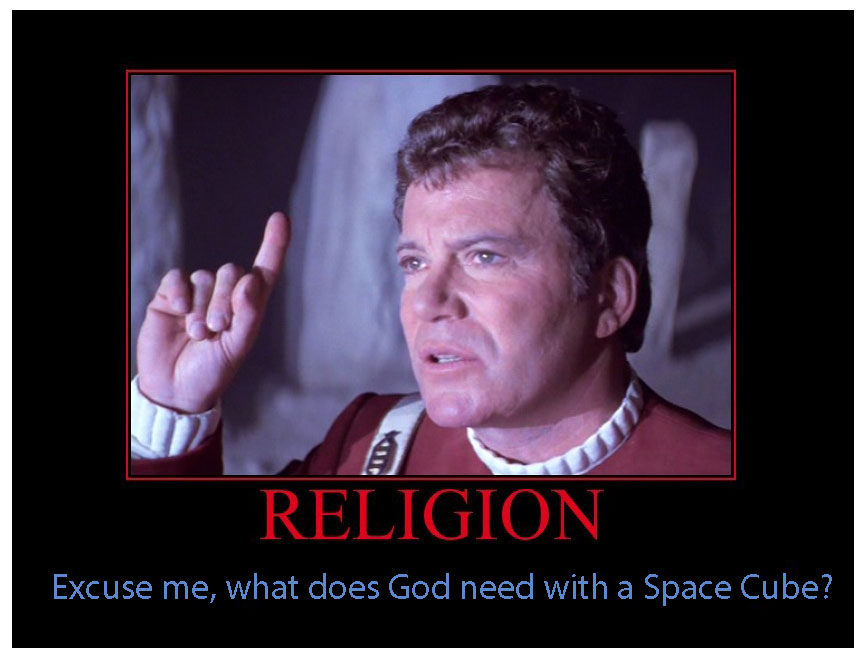
However, there are still fundamental differences in belief systems regarding true cosmology. The Creator God [a.k.a. the Demiurge] is within the Firmament in the Gnostic cosmology. In the Evangelical model, He has replaced Sophia and sits in the upper Pleroma within the lower Aeons [meaning not the upper Pleroma]. Here, the Trinity no longer exists within the common consensus of belief; he has taken the mantle of the only True God. When explaining away eschatology, it’s free will, but only till my Cube arrives. There is an intuitive component that is fundamental; this is what all these stories hint at, and it might also be a possible entrapment.
.
.

